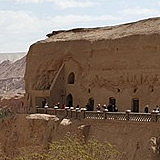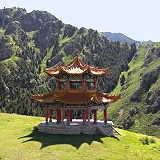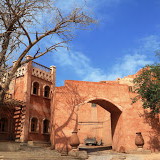Choose the Country:

|
Bezeklik Thousand Buddha Caves Gaochang District, Tu Lu Fan Shi, Xinjiang, China, 838015 Last Updated: 10/05/2023 |
| The Bezeklik Thousand Buddha Caves, also known as the Bizaklik Thousand Buddha Caves, is a historically and culturally significant site located in the Gaochang District of Turpan (Tu Lu Fan Shi), Xinjiang, China. These caves are renowned for their Buddhist art and murals, which date back over a thousand years. | |
| - Historical Significance: The Bezeklik Caves are part of a complex of Buddhist cave temples and monastic structures that were active during the Tang Dynasty (618–907 AD) and continued to be used until the 14th century. They were an important religious center along the Silk Road. - Cave Complex: The caves consist of a network of grottoes and chambers carved into the cliffs of the Flaming Mountains (Huoyanshan). These caves served as places of worship, meditation, and artistic expression. - Thousand Buddha Statues: While not all the caves contain a thousand Buddha statues, the name refers to the extensive collection of Buddhist murals and painted images of Buddhas, bodhisattvas, and other celestial beings found within the caves. - Buddhist Art: The murals and paintings in the Bezeklik Caves are of great artistic and historical value. They depict various scenes from Buddhist teachings, Jataka tales (stories of Buddha's previous lives), and everyday life along the Silk Road. The art provides insights into the culture and beliefs of the people who lived in the region during that time. - Restoration Efforts: Over the years, some of the murals have deteriorated or been damaged. Efforts have been made to restore and preserve these valuable artworks, allowing visitors to appreciate their beauty and historical significance. - Cave Layout: The caves are organized into several clusters, with each cluster containing multiple caves. Visitors can explore the different clusters and caves, some of which are open to the public. - Flaming Mountains: The Bezeklik Caves are situated at the base of the Flaming Mountains, which are known for their unique red rock formations. The dramatic landscape adds to the overall allure of the site. - Visitor Center: There is a visitor center near the caves that provides information about the history and significance of the site. It's a good starting point for your visit. - Turpan: The Bezeklik Caves are located near the city of Turpan, which is itself a historically significant Silk Road oasis town. Visitors to the caves can explore the wider region and its attractions, including the ancient city of Gaochang and the nearby Grape Valley. - Accessibility: Xinjiang is a remote region of China, and travel arrangements to Turpan should be made in advance. The caves can be reached by road from Turpan. The Bezeklik Thousand Buddha Caves offer a captivating glimpse into the ancient Buddhist art and culture of the Silk Road. They are a testament to the region's rich history and its role in the exchange of ideas and cultures along this ancient trade route. | |
Wikipedia Facebook
China » Xinjiang
Place » Historical Place

|
Xinjiang Place » City Xinjiang, officially known as the Xinjiang Uyghur Autonomous Region, is a vast and diverse region located in the far western part of China. It is the largest province-level administrative division in China and occupies a significant portion of Central Asia. Xinjiang is known for its rich cultural diversity, stunning natural landscapes, and historical significance. Its population was 25,890,000 in 2021. 28 views 💖 1China |

|
Kashgar Old City Place » Historical Place Kashgar, also spelled as Kashi or Kasgar, is a historically and culturally significant city located in the Xinjiang Uyghur Autonomous Region of China. It is one of the westernmost cities in China and has a rich history and unique cultural heritage. It is one of the oldest continuously inhabited cities in the world and has a population of 711,300 people (as of 2019). 126 views 💖 1China, Xinjiang, Kashgar, Kaxgar, Yawage Rd |
